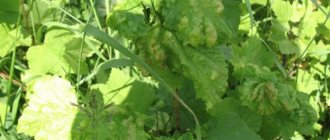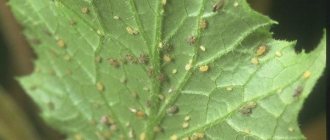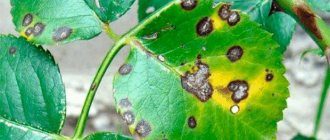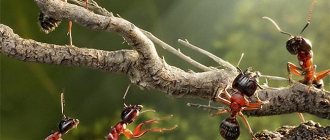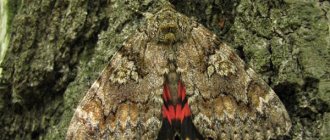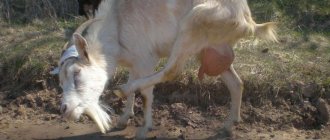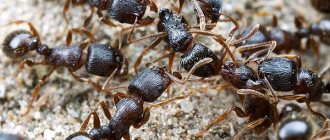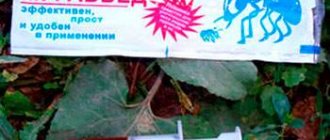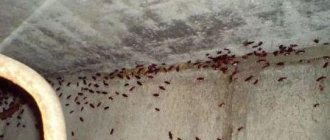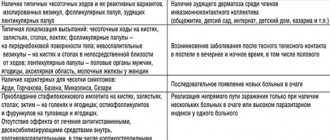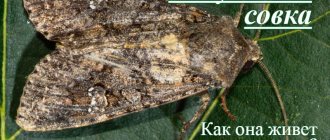Author: Tamara Altova. 09 September 2018
Category: Plant pests.
Cutworms are small whitish moths that resemble house moths and feed on garden crops. Moreover, it is not butterflies that damage plants, but their larvae - caterpillars. We will tell you how to deal with cutworms on tomatoes, which remedy for cutworms on tomatoes is considered the most effective, what folk remedies are available to combat cutworms and what chemicals will help get rid of this pest in tomato beds.
How to detect tomato cutworm in time
A careful inspection of the tomato bed will reveal signs of damage. The vegetable grower will not be able to see the butterfly itself. But the caterpillar feeds and traces of its “dinners” can be found. To do this you should inspect:
- leaves, especially the lower ones;
- shoots;
- buds;
- flowers.
Unfortunately, the vegetable grower becomes aware of the presence of cutworms on the plot only when he sees huge holes in the tomatoes. Sometimes you can see a caterpillar in them. Having made a hole, she decides not to leave, but to rest where she had eaten.
Salt to protect against caterpillars on tomatoes: recipe for use
Salt can also be used to remove cutworms from tomatoes.
Instructions:
- To do this, you need to dissolve 400 g of salt in 5 liters of water.
- This strong saline solution must be sprayed on the leaves. Try to work on the reverse side as well.
- You can also treat leaves that are as close to the ground as possible. This will help eliminate caterpillar attacks on leaves.
The saline solution turns out to be quite liquid, so in order for the liquid to stick well to the leaves, you can add 50 g of grated laundry soap to the resulting solution. It is crushed, added to water and stirred until the soap flakes dissolve. Mix with saline solution.
Salt from a scoop
Reasons for appearance
Sometimes a vegetable grower does not even suspect that there are cutworms on his plot. Pre-winter plowing and severe frosts regulate the pest population. Those that survive do not do much harm, except for a few eaten tomatoes.
The situation is different in the southern regions. The armyworm population is growing from year to year and it is becoming more and more difficult to fight. This is possible for the following reasons:
- Lack of autumn farming culture. If it is not customary to plow the soil in the fall or dig up the garden, the pupa becomes inaccessible to frost.
- Not thoroughly removing weeds and plant debris after harvesting the garden.
- A huge number of weeds in the garden or neighbors' plots. In this case, she has every chance of remaining unnoticed and continuing to reproduce.
Attention! If frost helps northerners, then southerners should clean their gardens more carefully.
Options for getting rid of the pest
Many chemicals have been developed to protect plants, but first you should try more environmentally friendly methods. Among them, special agrotechnical methods of soil cultivation, the use of special traps and the proper use of fertilizers stand out. But treating tomatoes against cutworms with powerful insecticides, which many summer residents consider to be the only option, despite its effectiveness, can have serious side effects.
Secrets of agricultural technology
- Remove all weeds from the area regularly. This is a rather tedious task, but in many cases you can thereby get rid of the pest without using any chemicals.
- The cutworm on tomatoes really does not like being in close proximity to some medicinal plants. Therefore, areas planted with tomatoes should be planted, for example, with calendula.
- At the end of the season, after harvesting, carefully dig up the soil. By doing this, you will not only prepare it for the cold season, but also destroy the wintering larvae. The optimal depth is at least 15-20 centimeters.
- Manual pest removal. A very effective technique if the fall armyworm has not yet spread on the tomatoes.
The harmfulness of the cotton bollworm lies in the spoilage of fruits
Folk remedies
- Spray the plantings with infusion of garlic arrows 2-3 times a month. To do this, take 400-500 g of carefully crushed raw materials, fill a 3-liter jar with it and fill it to the brim with water. Let the product brew for 5-7 days and strain. For 10 li of clean water you will need 50-60 g of product and the same amount of crushed laundry soap. The technique is effective for all types of pests (including if your area is occupied by the cotton bollworm).
- A decoction of wormwood is great for spraying. You will need 600-700 g of fresh herbs, which should be poured into 5 liters of boiling water and left for several days in a dry and dark place. Before use, dilute the prepared infusion with water in a ratio of 1:10.
- The universal infusion is a safe and effective preparation for the cutworm on tomatoes. It is prepared on the basis of tobacco, celandine, wormwood and shag (70-80 g of each ingredient). Add 160-180 g of chopped garlic and 10 liters of hot water to the resulting mixture, then mix the mixture thoroughly and leave for a day. Immediately before spraying, add a little crushed laundry soap (about 1/4 of a bar).
Practice-tested insecticides
If the infestation is large, it is important to choose drugs that destroy the armyworm at different stages of development.
- "Lepidocide." A powerful biologically active drug that helps cope with many pests. Consumption rate - from 0.5 to 1 liter of substance per hectare (volume of working fluid - from 200 to 400 l). The processing interval is 7-8 days.
- "Decis Expert". A universal contact preparation with a wide spectrum of action. The duration of action, if you are specifically interested in protecting tomatoes, is at least 14 weeks, and the first results can be observed after 1-2 hours. Consumption rate - 0.1 l per hectare (volume of working fluid - 200-400 l). Apply strictly during the growing season.
- "Karate Zeon". A good pyrethroid insecticide that also copes with the disinfestation of granaries. The consumption rate is 0.3-0.4 liters per hectare (for its processing you will need 300-400 liters of the mixture). To enhance the effect, we recommend treating the area twice with an interval of 30-35 days. Prepare the mixture immediately before spraying. "Karate Zeon" is effective against many types of pests, which also include the cotton bollworm.
- "Arrivo". Contact insecticide with high resistance to heat, economical and very effective. The consumption of the drug is about 0.3 liters per hectare (to treat 1 hectare you will need from 200 to 400 liters of the mixture). It is sold under the names “Shar Pei”, “Cyperon”, “Sherpa” and “Tsitkor”.
- "Inta-Vir". The drug is effective against 52 types of garden and vegetable pests. Available in the form of tablets (8 g) or water-soluble powder. Belongs to the category of moderately dangerous. If the armyworm on tomatoes has become particularly prolific, Inta-Vir can be used simultaneously with other pesticides if they do not have a strong alkaline reaction. Consumption rate – 1 tablet per 10 liters of water, spraying should be carried out during the growing season.
- "Proclamation." A translaminar insecticide, the main difference from its analogues is its natural origin. The main active ingredient is emamectin benzoate. The optimal use scheme if the cutworm on tomatoes bothers you is from 0.3 to 0.4 liters per hectare, liquid consumption is standard (200-400 liters of mixture). It is not recommended to use the product together with preparations based on fosethyl aluminum and liquid mineral fertilizers.
Attention! Not all drugs against cutworms can be used to get rid of other garden and garden pests.
All the measures to destroy armyworms on tomatoes that you met in this article have proven their effectiveness many times. Although experienced tomato growers in some cases (rare soil type, special weather conditions) use their own recipes. We are sure that you also have your own secrets on how to deal with cutworms on tomatoes. We will be glad if you share it with us readers.
Signs of defeat
The cutworm butterfly can only be seen at night. But its presence in a tomato plot is not difficult to notice:
- If you look closely at the underside of tomato leaves, you can see eggs. If there are not many insects, then searching for oviposition may be difficult;
- the lower leaves on the tomato bushes, and then the upper ones, become scabbed. The caterpillar eats away the soft tissue of the leaf blade, but the vein remains. So she moves from the lower leaf to the upper one, leaving behind the skeletons of the leaves;
- You can catch the caterpillar eating and examine it late in the evening, when it has already climbed up the shoot to the leaf;
- if there are a lot of insects, then the tomato plantings look gloomy: the leaves and buds are worn out, the fruits are holed. Further, the caterpillar becomes more and more voracious and the tomatoes become covered with eaten holes;
- the gnawed leaf begins to turn black and dry out;
- large brown tomatoes are trying to heal, but they have little success. The process of decay begins.
Description and types
The noctuid moth is an insect that belongs to the largest family of Lepidoptera. The family has about 1,000 genera and 12,000 species. The cutworm is a small butterfly with a round head and two pairs of wings. It has a dim color and a triangular shape, folds its wings horizontally along the body and leads a nocturnal or evening lifestyle, lays eggs 0.3 mm long.
The armyworm lives up to 6 instars, accompanied by molting. It goes through several stages of development from larva to butterfly. They overwinter well in the pupal, egg and even caterpillar stages. The length of the caterpillar is 3-4 cm with different colors depending on the species. It can be from light gray to black.
In nature, there are several types of cutworms that can infect tomatoes.
Cotton
The armyworm is an omnivorous pest, which is a butterfly with a wingspan of 3-4 cm. Its color can be gray-yellow with reddish, green or other shades; in the center of the wings there is a dark spot similar to a sickle. The caterpillar itself is covered with small growths in the form of thorns. The body has three dark horizontal stripes at the top and one yellow stripe at the bottom.
At the beginning of its maturation, the armyworm feeds on leaves, then eats stems and tomatoes. Its fertility is quite high - from 200 to 300 eggs. The entire cycle of its development from egg to adult butterfly depends on the ambient temperature, but on average it is 30-35 days, 13-22 days of which are for the maturation of the larva.
The threshold of harmfulness for tomatoes is 10-12 larvae per 100 bushes, only in this case they pose a threat to this crop.
Scoop Gamma
It lives in almost the entire European part of Russia, it affects more than 100 species of cultivated plants, including tomatoes. The pest can be gray or brown with a purple tint. The wingspan of the butterfly varies from 4 to 4.8 cm.
It received this name because of the spots that are on the front pair of wings and resemble the Greek letter “gamma”.
Caterpillars that eat tomatoes are green in color and have white stripes on their bodies. Spiracles are yellow. They are characterized by black spots on the sides of their heads.
The larva of such a cutworm goes through 5 life cycles. At the first stage, it needs very high humidity and is of the leaf-eating type. It eats all the plates of tomatoes, leaving only large veins on the leaves. Gradually, as she grows up, she begins to gnaw on the flowers and fruits of tomatoes.
exclamation point
This cutworm is polyphagous and can live throughout Europe and even in the northern regions. It affects about 75 plant species, including tomatoes. In the northern part it gives one generation, and in the southern part - two. A butterfly with a wingspan of 3 to 4.5 mm has a gray and yellow color, maybe with a brown tint. There are rod-shaped, round or wedge-shaped spots on its body.
Life cycle
Depending on the species and area of distribution, the life cycle differs slightly in time, but is basically as follows:
- a butterfly that lays eggs on a leaf plate at night;
- they mature and after some time the larva, the caterpillar, hatches;
- young caterpillars feed on the leaf and, as they grow, move away from each other in search of food;
- During the growth period, they molt and, having reached maturity, fall to the ground to pupate. By secreting sticky substances and sticking dust to itself, the cocoon becomes the same as that of other butterflies. It can lie on the ground or be slightly buried 2-4 cm in the ground. The growth of the pupa lasts from 3 to 30 days;
- After some time in the summer, a butterfly flies out of the pupa. If it is deep autumn, the pupa overwinters in the ground;
- The emerging butterfly still needs food for the maturation of reproductive products. For several days she feeds on pollen, then mates;
- Now she again lays eggs on the bottom of the leaf.
The life cycle of the cutworm in northern latitudes is interrupted by cold and frost. In the southern regions it is continuous.
Why do caterpillars appear in a greenhouse?
Caterpillars enter the greenhouse in two main ways:
- An adult flew into a greenhouse and laid eggs. Caterpillars have already developed from them.
- The soil in the greenhouse is contaminated - pupae and larvae remain from last season. With the onset of warmth, they become active, quickly develop and reproduce.
Cutworms and whiteflies are attracted by the comfortable greenhouse microclimate - warmth, humidity. Therefore, I do not forget to ventilate the greenhouse to get rid of condensation and ensure normal air circulation.
Pests also love overly thickened plantings - they lay eggs there. Therefore, timely weeding, thinning, and formation of cultivated plants are so important. Do not forget to cut off stepsons, old lower branches, and unnecessary side shoots.
Prevention measures
Farming practices will greatly help to get rid of armyworms on tomatoes in large quantities, although it is difficult to completely defeat the pest. By adhering to simple rules and following agrotechnical methods, you can protect the crop already in the next season. To do this you need:
- carry out autumn plowing of the garden and fallow;
- monitor the cleanliness of the vegetable plot and promptly control weeds;
- carry out regular irrigation of crops. It has been observed that noctuid moth pupation does not occur on irrigated soils;
- Apply insecticides promptly to combat armyworm caterpillars.
Additional Tips
Timely use of chemicals or home recipes to get rid of caterpillars can give good results.
Here are some more useful tips to help make your fight against armyworms more effective:
- when treating tomato bushes with chemicals, you must strictly follow the instructions indicated on the packaging;
- observe the timing of repeated treatments of tomatoes; on average, the interval between sprayings is from 7 to 14 days;
- chemicals against the pest are used only during the growth and flowering of tomatoes or the formation of ovaries;
- to destroy caterpillars hiding in the ground during the day, regularly loosen the soil between the rows of tomatoes;
- If a small number of pest eggs are found on plant leaves, they can be carefully collected by hand until the caterpillars appear.
Important! To combat the cutworm during the ripening and harvesting period of tomatoes, only folk remedies are used.
What does a tomato scoop look like photo
Looking at the photo of the scoop, you can understand that moths have an unusual and very diverse color. We must remember that they are all pests and eat everything.
The classification of cutworms is approximate and is constantly being improved. This is why one scoop is often confused with another, and this is not strange.
Mechanical methods of control
Some gardeners collect cutworm larvae and large ovipositors on tomatoes by hand. But this can be done if the bed is small, but on a farmer’s field it is very problematic.
It is much easier to set up traps for cutworm butterflies in beds with tomatoes, both in a greenhouse and in open ground:
- place containers filled with beer, fermented jam or molasses diluted 3 times with water;
- Like all nocturnal moths, cutworms willingly fly into the light; they can easily be sprayed with insect repellent from a spray can or, if desired, killed by hand.
Options for getting rid of the pest
Many chemicals have been developed to protect plants, but first you should try more environmentally friendly methods. Among them, special agrotechnical methods of soil cultivation, the use of special traps and the proper use of fertilizers stand out. But treating tomatoes against cutworms with powerful insecticides, which many summer residents consider to be the only option, despite its effectiveness, can have serious side effects.
Secrets of agricultural technology
- Remove all weeds from the area regularly. This is a rather tedious task, but in many cases you can thereby get rid of the pest without using any chemicals.
- The cutworm on tomatoes really does not like being in close proximity to some medicinal plants. Therefore, areas planted with tomatoes should be planted, for example, with calendula.
- At the end of the season, after harvesting, carefully dig up the soil. By doing this, you will not only prepare it for the cold season, but also destroy the wintering larvae. The optimal depth is at least 15-20 centimeters.
- Manual pest removal. A very effective technique if the fall armyworm has not yet spread on the tomatoes.
The harmfulness of the cotton bollworm lies in the spoilage of fruits
Folk remedies
- Spray the plantings with infusion of garlic arrows 2-3 times a month. To do this, take 400-500 g of carefully crushed raw materials, fill a 3-liter jar with it and fill it to the brim with water. Let the product brew for 5-7 days and strain. For 10 li of clean water you will need 50-60 g of product and the same amount of crushed laundry soap. The technique is effective for all types of pests (including if your area is occupied by the cotton bollworm).
- A decoction of wormwood is great for spraying. You will need 600-700 g of fresh herbs, which should be poured into 5 liters of boiling water and left for several days in a dry and dark place. Before use, dilute the prepared infusion with water in a ratio of 1:10.
- The universal infusion is a safe and effective preparation for the cutworm on tomatoes. It is prepared on the basis of tobacco, celandine, wormwood and shag (70-80 g of each ingredient). Add 160-180 g of chopped garlic and 10 liters of hot water to the resulting mixture, then mix the mixture thoroughly and leave for a day. Immediately before spraying, add a little crushed laundry soap (about 1/4 of a bar).
Practice-tested insecticides
If the infestation is large, it is important to choose drugs that destroy the armyworm at different stages of development.
- "Lepidocide." A powerful biologically active drug that helps cope with many pests. Consumption rate - from 0.5 to 1 liter of substance per hectare (volume of working fluid - from 200 to 400 l). The processing interval is 7-8 days.
- "Decis Expert". A universal contact preparation with a wide spectrum of action. The duration of action, if you are specifically interested in protecting tomatoes, is at least 14 weeks, and the first results can be observed after 1-2 hours. Consumption rate - 0.1 l per hectare (volume of working fluid - 200-400 l). Apply strictly during the growing season.
- "Karate Zeon". A good pyrethroid insecticide that also copes with the disinfestation of granaries. The consumption rate is 0.3-0.4 liters per hectare (for its processing you will need 300-400 liters of the mixture). To enhance the effect, we recommend treating the area twice with an interval of 30-35 days. Prepare the mixture immediately before spraying. "Karate Zeon" is effective against many types of pests, which also include the cotton bollworm.
- "Arrivo". Contact insecticide with high resistance to heat, economical and very effective. The consumption of the drug is about 0.3 liters per hectare (to treat 1 hectare you will need from 200 to 400 liters of the mixture). It is sold under the names “Shar Pei”, “Cyperon”, “Sherpa” and “Tsitkor”.
- "Inta-Vir". The drug is effective against 52 types of garden and vegetable pests. Available in the form of tablets (8 g) or water-soluble powder. Belongs to the category of moderately dangerous. If the armyworm on tomatoes has become particularly prolific, Inta-Vir can be used simultaneously with other pesticides if they do not have a strong alkaline reaction. Consumption rate – 1 tablet per 10 liters of water, spraying should be carried out during the growing season.
- "Proclamation." A translaminar insecticide, the main difference from its analogues is its natural origin. The main active ingredient is emamectin benzoate. The optimal use scheme if the cutworm on tomatoes bothers you is from 0.3 to 0.4 liters per hectare, liquid consumption is standard (200-400 liters of mixture). It is not recommended to use the product together with preparations based on fosethyl aluminum and liquid mineral fertilizers.
Attention! Not all drugs against cutworms can be used to get rid of other garden and garden pests.
All the measures to destroy armyworms on tomatoes that you met in this article have proven their effectiveness many times. Although experienced tomato growers in some cases (rare soil type, special weather conditions) use their own recipes. We are sure that you also have your own secrets on how to deal with cutworms on tomatoes. We will be glad if you share it with us readers.
